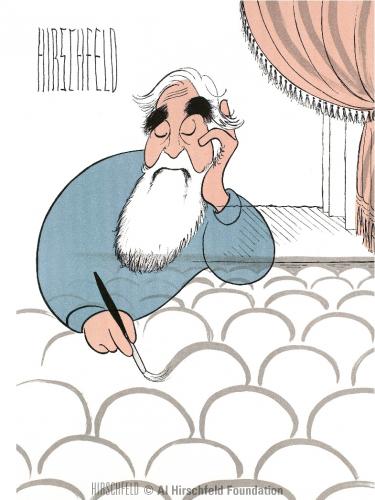Art News Review of NYPL Show
The Line King's Library exhibition that closed at the New York Public Library for the Performing Arts on January 4th, continues to receive rave reviews. This piece appears in the February issue of Art News, one of the most prestigious art magazines int he country,and we think it does a great job of not only detailing the exhibition, but offers insight into Hirschfeld's art.
It must have been great to be Al Hirschfeld, whose sketches immortalized generations of Hollywood and Broadway stars and whose surname became a verb. Being “Hirschfelded” (i.e., drawn by the artist) meant being inducted, with a wink, into the inner sanctum of the performing arts.
His drawing, prints, paintings, and ephemera were on view in “The Line King’s Library: Al Hirschfeld at The New York Public Library,” placing his 82-year career in the context of influences and friendships.
The exhibition highlighted two early sources of inspiration: Hollywood and a trip to Bali. From film stars such as Katharine Hepburn and Humphrey Bogart, he learned to select gestures and expressions that instantly defined a persona. In Indonesia, amid dancers and puppets, he saw people as “line drawings walking around.”
Hirschfeld’s fluid calligraphic mark was the height of his achievement. A straight diagonal slash describes Vladimir Horowitz’s back. A few strokes evoke Brando’s flat forehead and fat lower lip, Baryshnikov’s sloping shoulders, and Tennessee Williams' off-center hairline.
While capable of economy, Hirschfeld could be quite elaborate. Leonard Bernstein (ca. 1958) is a three-headed dynamo lost in reverie, smiling at the public, and scowling, while a flurry of hands performs tasks from answering the phone to conducting. Ted Shawn’s lithe form visually mimics a chorus line of trees vanishing into the distance.
After the birth of his daughter, Nina, Hirschfeld began concealing her name in his drawings: in the folds of skirts, in the kinks of hair, and virtually everywhere else that wasn’t obvious. For readers of the New York Times, this diversion added a new layer of delight to drawings so sophisticated that subtle character traits are revealed in a curlicue.
Hirschfeld understood that the moving line could be a metaphor for almost anything. His fans compared it to music, dance, prose, and theater. One thing is certain—the drawings themselves are virtuoso performances, every bit as much as the events they capture. When everyone who remembers these 20th-century performances is gone, Hirschfeld’s drawings will preserve a sense of what it was like to be there.
-Johanna Ruth Epstein
